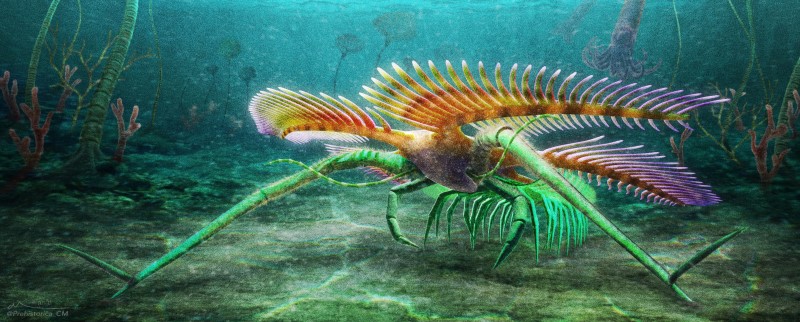Remarkably preserved 450-million-year-old marine animal discovered in Ontario
Published
Category
Press Release
Researchers discover a new species, Tomlinsonus dimitrii, a late Ordovician arthropod. See it on display in ROM’s Willner Madge Gallery, Dawn of Life

TORONTO, April 19, 2022 – ROM (Royal Ontario Museum) announces the discovery of a very rare marine fossil species Tomlinsonus dimitrii, discovered near Brechin (Lake Simcoe area in Southern Ontario). Known from a single specimen, this delicate late Ordovician fossil (ca. 450-million-year) of an extinct group of arthropod is exceptionally well preserved. This finding was announced on March 24, 2022, in the Journal of Paleontology.
Most often, it is only the hard parts of the organism, the shells or bones, that are preserved as fossils. This newly described species lacks any mineralized body parts, defying this trend. In life, this species was entirely soft-bodied and normally its body would typically not be preserved.
No longer than an index finger, this new species belongs to an extinct group of soft-bodied arthropods called marrellomorphs, a group better known from older fossil sites like the famous Cambrian Burgess Shale in British Columbia. “Tomlinsonus has an ornate head shield adorned with remarkable feather-like spines. This strange-looking animal probably negotiated the muddy seafloor using a pair of exceptionally long, stilt-like limbs,” said lead author Joe Moysiuk, a Ph.D. candidate in Ecology & Evolutionary Biology at the University of Toronto, who is based at ROM. This species lived in a shallow tropical marine sea, which covered most of Ontario at that time and the seafloor was periodically blanketed in sediment by storms, entombing any organisms living there.
“We called it Paleo Pompeii,” said George Kampouris, co-author and an independent paleontological technician who initiated a project in 2014 to investigate fossil beds in the Lake Simcoe area. “Brechin has produced world-class fossils for over 100 years but our work here has revealed the role of catastrophic storm events in the burial and preservation of entire animal communities in their final moments.”
The discovery was made during formal excavations at a stone quarry owned by the Tomlinson Group for whom the new fossil is named. “Tomlinson gave us unprecedented support,” said Kampouris, “This allowed us to carefully excavate large study areas, layer by layer to reconstruct the entire seafloor and record these incredible reef communities.”
One of the goals of the project was to assemble scientifically important and display quality material that would become part of ROM’s collection. Many of the most spectacular fossil pieces, including Tomlinsonus, were donated by Kampouris to the Museum. While this spectacular collection includes beautifully preserved skeletons of marine animals, mainly crinoids and trilobites, the marrellomorph is perhaps the single greatest find because it constitutes the first report of the preservation of non-mineralized organisms in this area. “Finding soft tissue preservation, in particular of a type of soft-bodied animal resembling Marrella splendens from the Burgess Shale in British Columbia, was a huge surprise, as it’s not been seen in deposits representing the shallow reefs that occupied widespread open waters across eastern North America during the Ordovician period, and is very rare in general,” said Dr. Jean-Bernard Caron, ROM Richard Ivey Curator of Invertebrate Palaeontology and co-author of the paper. “The finding of entirely soft-bodied species like Tomlinsonus allows a much better understanding of the diversity of life that really existed at that time.”
The researchers are convinced that Tomlinsonus helps close a gap in the sparse fossil record of this group. “Marrellomorphs are really scarce in the fossil record, so this new discovery is a big advance in understanding the evolution, paleobiology and distribution of this group” added Alejandro Izquierdo Lopez, also a U of T Ecology & Evolutionary Biology student and co-author. More generally, the soft-bodied fossils of the Brechin area represent a rare window into Ordovician open ocean shelf environments in North America. With future collecting efforts, the researchers believe Brechin offers great potential for further similar discoveries.
Visitors to ROM can see the fossil of Tomlinsonus on display in the newly opened Willner Madge Gallery, Dawn of Life’s Burgess Shale section which contains numerous other fossils of remarkable soft-tissue preservation. More fossils from the Brechin area are also on display in the Ontario Fossil section of the gallery.
-30-
REFERENCE
Moysiuk, J., Izquierdo-López, A., Kampouris, G., & Caron, J. (2022). A new marrellomorph arthropod from southern Ontario: A rare case of soft-tissue preservation on a Late Ordovician open marine shelf. Journal of Paleontology, 1-16.
Doi:10.1017/jpa.2022.11
CONTACTS:
David McKay, ROM Senior Communications Specialist, davidm@rom.on.ca or Media@rom.on.ca


